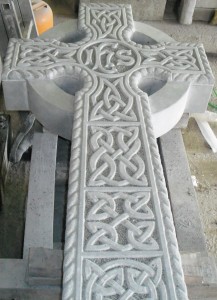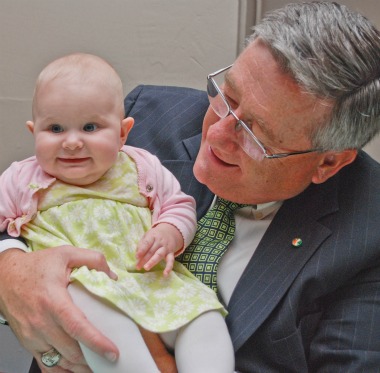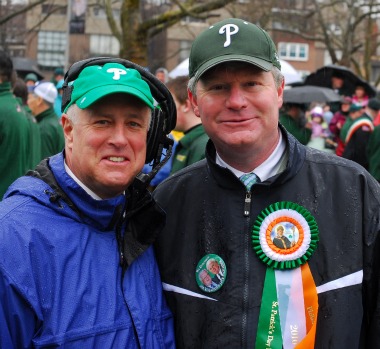
Duffy's Cut Memorial Cross Designed by Johnnie Rowe
From the beginning of the Duffy’s Cut project, back in 2002, Bill and Frank Watson knew there was a possibility that they would not be able to recover the bodies of the 57 Irish workers who died in 1832 under mysterious circumstances while building Mile 59 of the Pennsylvania Railroad. But the brothers—historians-turned-archaeologists—successfully located and excavated the first seven bodies, and the dream of finding and retrieving the rest of the workers looked increasingly realizable.
Until last week when Amtrak officials informed the team that the bodies in the mass grave were located too near to the tracks that are still in use today, and are therefore unreachable.
For 170 years, the story of Duffy’s Cut was simply an urban legend that had been passed down by locals through the centuries, the tale of railroad laborers buried alongside the Malvern Curve. But when Frank Watson inherited a file from his grandfather, who had worked as an assistant to many of the railroad’s presidents throughout his career, the legend became a true life tale of Irish immigrants who suffered the reality of prejudice, cholera and murder before being deliberately erased from history.
The summer of 1832 brought the ship The John Stamp to dock in Philadelphia, plentiful with Irish laborers eager to find work. Philip Duffy, the man charged by the Philadelphia & Columbia Railroad to build the dangerous section of track called Mile 59, met them as they came ashore and offered them jobs. Within six weeks, all these men (and at least one woman) were dead, supposedly from the effects of cholera which had become an epidemic in the area. Consigned to a mass grave, these immigrants were quickly forgotten and the details of their deaths covered up.
Frank and Bill Watson, in possession of the original file amassed by Martin W. Clement, the last president of P&C Railroad before it was bought out, and then given for safekeeping to their grandfather, Joseph F. Tripician, began the arduous task of setting up an archaeological dig at the site. Over the past several years, their efforts have paid off beyond all expectations.
Artifacts found at The Duffy’s Cut site include buttons, bowls, forks and pipes from the men’s home counties of Derry, Donegal and Tyrone. Working with forensic dentist Matt Patterson, University of Pennsylvania anthropologist Janet Monge and geophysicist Tim Monge, plus a dedicated team of students, the Watsons recovered seven bodies buried on the site, yet set apart from the mass grave. These first seven were six men and one woman who tried to flee the quarantined camp, but were hunted down by a local vigilante group known as The East Whiteland Horse Company. All of these victims show the effects of murder, from blunt force trauma to their skulls to bullet holes. It seems they were tended to by a local blacksmith named Malachi Harris, who built coffins for them and gave them their own burials.
Many details yielded by the bones of these seven have helped to provide clues to their identities. The body of one victim matched up by age to one of the immigrants listed on the John Stamp’s ship list; John Ruddy was the youngest of the laborers, and DNA testing is underway with descendants of the Ruddy family back in Donegal to see if there is a positive match. It turns out that John Ruddy had a distinctive dental trait: he was missing an upper right molar, a genetic quirk that is also shared by other Ruddys in Donegal.
The discovery that one of the bodies was a woman was another revelation. Several of the men on the ship were traveling with female relatives, and the bones seem to point to her identity as Catherine Burns, a 29 year old woman listed on the ship’s manifest. The condition of her stooped shoulders show that she was most likely a washerwoman, and certainly used to hard labor.
With the advance of technology, Tim Bechtel was able to use electrical imaging and seismic surveys to positively locate the mass grave where the majority of the laborers had been buried. But what his equipment showed is that these victims are buried 30 feet below ground level, level with the line of tracks as they were originally built in 1832.
“It’s a huge area,” Frank Watson explained. “So they’re all there together. But because they’re 30 feet down, there’s no way to safely excavate. If we started excavating at any spot along there, it would probably destroy the memorial wall and could possibly undermine the tracks.”
The news that Amtrak was not allowing excavation at the mass burial site came as a disappointment to the team, to know that they were so close to recovering the bodies of the workers but that any serious digging in that location was off limits due to safety concerns.
They’re taking the frustration in stride, however, and the work at the site is far from over.
“We can stay as long as it takes,” Watson explained. “We’ve been working on this last body that was under a large tree. We have the skull and all but one tooth. The teeth are in great shape, considering that the roots of the tree went through his skull and more roots had broken through his jaw, separating the upper and lower, actually splitting the jaw in half.
“We also found pewter buttons buried with him, probably from a haversack, together with a Barlow pocket knife. These are likely some of the best preserved items from an Irish-American laborer’s grave from the 1832 era.
“We still have so much more work to do.”
That work includes proper burials for these bodies that have been rescued. If the body that is thought to be John Ruddy is proven to be part of the Donegal Ruddy family, it’s likely that he will be sent home and laid to rest. For the others, interment at West Laurel Hill Cemetery in Bala Cynwyd has been arranged, and a Celtic memorial cross has been designed and built to commemorate the laborers. Johnnie Rowe, from County Laois, has created a hand-carved cross and ledger from Kilkenny limestone that’s been shipped over and will be placed at the graves of the Duffy’s Cut victims. The ceremony is planned for March of 2012.
So the work of the team will continue. In fact, they’ve been called in to investigate what is thought to be a Potter’s Field in nearby Downingtown. The back story is that possibly one of the men from Duffy’s Cut was able to escape from the camp, then went and infected other Irish workers in the nearby town, leading to another mass anonymous burial ground. The possible connection to Duffy’s Cut makes this especially intriguing.
Amtrak’s pronouncement that there will be no excavation of the mass grave site may be a disappointment, but ultimately it doesn’t detract from the importance of the discovery at Duffy’s Cut.
“The most important thing is that the story is being told,” Frank Watson affirmed. “After being ignored for all these years, they have definitely earned a place in the Irish American pilgrimage.”
Duffy\’s Cut Photos









